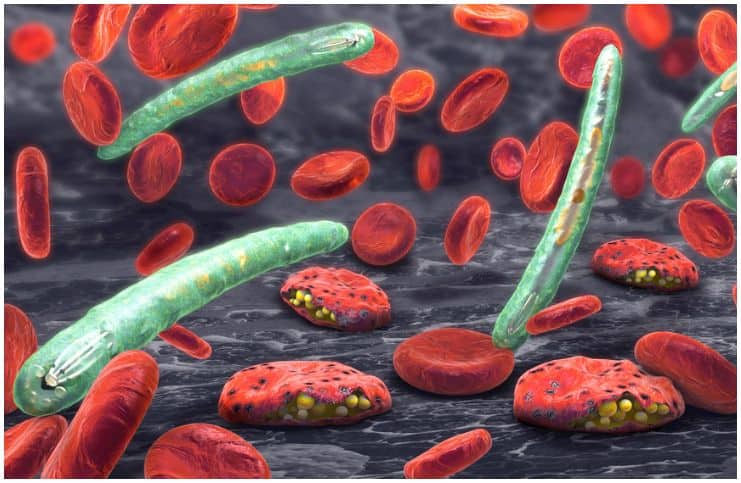Here are the top 25 interesting facts about malaria:
#1 It is a life-threatening condition that is usually transmitted through the bite of an infected Anopheles mosquito – the only mosquito species known to carry this parasite.
#2 These parasites can also be transmitted by blood transfusions, although this is quite rare. In addition, an infected mother can spread them through the placenta to her unborn child.
#3 Once you are bitten, the parasite enters the bloodstream and moves to the liver, where it can remain dormant for seven days up to 10 months – before it starts reproducing and infecting the human body’s red blood cells.
#4 The infected individuals may experience influenza-like symptoms, feverish attacks, diarrhea, tiredness, or a variety of other symptoms.
#5 There are five species of Plasmodium which can infect humans: Plasmodium knowlesi (very rare), Plasmodium ovale, Plasmodium malariae, Plasmodium falciparum, and Plasmodium vivax.
#6 While this condition is uncommon in temperate climates, it is still prevalent in subtropical and tropical countries.
#7 Humans who have lived all their life in a country with a high rate of this condition have generally been exposed to these parasites countless times. However, after the first exposure, the immune system starts to protect you, therefore, re-infection may cause no symptoms.
Statistics
#8 According to the World Health Organization (WHO), in 2015 this condition caused 212 million new cases and 429,000 deaths, with about 90 percent of these cases happening in Africa. Also, approximately 80% were children under 5 years of age.
#9 Between 2010 and 2015, the incidence of this condition among populations at risk reduced by 21 percent globally.
#10 In the present day, about 3.2 billion people live in countries at risk of this parasite transmission.
#11 It was a serious public health threat in the United States until it was eliminated during the 1920s-1940s. Currently, about 1,500 cases are reported by the United States by healthcare professionals per year, and 5 of those cases are fatal.
#12 The majority of cases in the US are in immigrants and travelers returning from parts of the world where the transmission of this parasite still occurs, especially in South Asia and sub-Saharan Africa.
#13 About 350 to 1,000 annual cases of this condition occur in Canada (with 1 to 2 deaths), most likely due to the fact that approximately 1 million Canadians travel to malaria-endemic areas every year.
#14 The World Health Organization estimates that 25 million pregnant women are at risk for being infected with this parasite with more than 200,000 neonatal and 10,000 maternal deaths a year.
#15 It not only causes the loss of human life in tropical and subtropical countries, but is also responsible for great economic loss due to increased health care costs, decreased workforce, and lower rates of tourism.
Symptoms
#16 It can take anywhere from 10 to 40 days for symptoms to occur. Also, the incubation period may be longer if the patient has some immunity (because of previous infections) or is taking medicine to prevent infection.
#17 The initial symptoms look similar to the common flu and include – vomiting, chills, sweats (usually followed by a return to normal temperature, with tiredness), headache, fever, seizures (particularly in younger people).
#18 This condition is regarded as uncomplicated when the signs and symptoms are present but there are no clinical signs to indicate vital organ dysfunction. These symptoms are non-specific and frequently include fever.
#19 Plasmodium falciparum causes a severe form of malaria. Symptoms include:
- severe hemolytic anemia caused by the destruction of the red cells;
- fever;
- pulmonary edema (fluid in the lungs);
- yellow skin discoloration;
- general convulsions;
- kidney failure;
- acute renal failure;
- coma;
- circulatory collapse.
#20 Plasmodium vivax is common in Latin America and Asia. The symptoms and signs caused by this type of parasite are less severe than Plasmodium falciparum.
#21 Plasmodium ovale is usually found in the islands of the western Pacific and Africa (particularly West Africa). It is morphologically and biologically very similar to Plasmodium vivax.
Diagnosis
#22 The best method of diagnosing this condition is to look at samples of a patient’s blood down a microscope since the symptoms of this condition can be similar to those of other conditions.
Treatment
#23 Early diagnosis and treatment of this condition are essential to prevent complications and deaths. In addition, early diagnosis contributes to reducing transmission.
#24 The most frequent medicines used include – a combination of proguanil (Malarone) and atovaquone, hydroxychloroquine (Plaquenil), quinine sulfate (Qualaquin), chloroquine (Aralen). These meds are generally taken either intravenously, orally, or by injection.
Prevention
#25 The transmission of this parasite can be reduced by mosquito control by spraying insecticides inside draining standing water (where usually mosquitoes lay their eggs) and houses, or by preventing mosquito bites with insect repellents and mosquito nets.
Images credit – Shutterstock
READ THIS NEXT: Facts About Pneumonia
